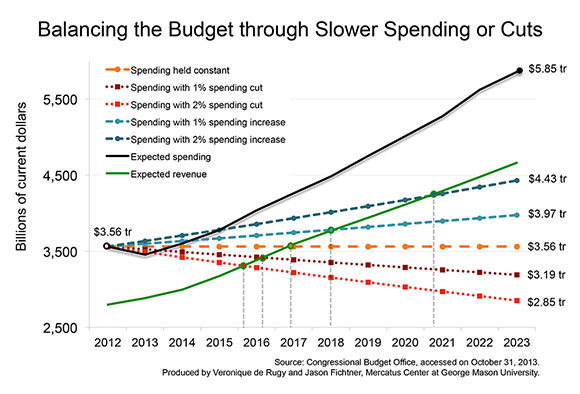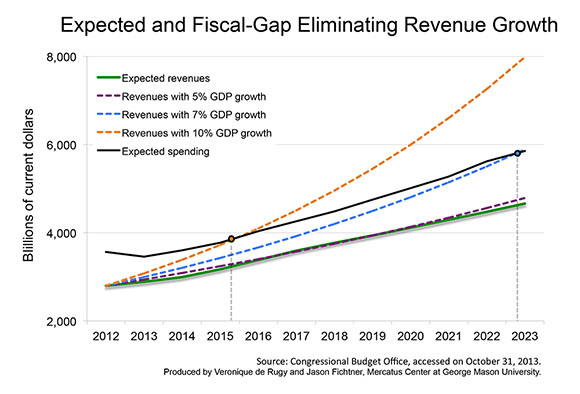- | Government Spending Government Spending
- | Data Visualizations Data Visualizations
- |
Spending Cuts vs. Revenue Growth: How Best to Eliminate the Fiscal Gap?
What is the best way for the United States to get its fiscal house in order in the short term? Last week, we analyzed how much the US economy would have to grow by each year for public finances to balance by 2023. This week, we will compare this option to minor changes in public spending. This week’s charts use data from the Congressional Budget Office to highlight the US fiscal position over the next ten years. These charts display revenue and outlay projections over the next ten years under different assumptions of growth rates and spending changes.
What is the best way for the United States to get its fiscal house in order in the short term? Last week, we analyzed how much the US economy would have to grow by each year for public finances to balance by 2023. This week, we will compare this option to minor changes in public spending. This week’s charts use data from the Congressional Budget Office to highlight the US fiscal position over the next ten years. These charts display revenue and outlay projections over the next ten years under different assumptions of growth rates and spending changes.
This week’s charts use data from the Congressional Budget Office to highlight the US fiscal position over the next ten years. These charts display revenue and outlay projections over the next ten years under different assumptions of growth rates and spending changes.
The first chart displays the CBO’s expected outlays and revenues along with the revenues that would be generated under different GDP growth scenarios. The chart shows that neither CBO’s expected revenues nor the revenues generated through annual growth rates of five percent are sufficient to close the fiscal gap within the next ten years. With an annual growth rate of seven percent, the fiscal gap will be closed by 2023. A miracle annual growth rate of 10 percent would close the gap during 2015. The second chart displays the CBO’s expected outlays and revenues along with outlays under various cut and slow down scenarios. The chart shows that if the federal government were to cut or merely slow down the growth rate in outlays, the fiscal gap could be easily closed within the next decade. Holding revenue constant, limiting outlays to grow by only two percent a year will balance federal finances during 2020. If outlays only grow by one percent, federal deficits will be eliminated by 2018. A spending freeze would balance finances by 2017. Cutting spending by tiny percentages each year yields even faster results: annual spending cuts of one and two percent will balance the budget by 2016.
The second chart displays the CBO’s expected outlays and revenues along with outlays under various cut and slow down scenarios. The chart shows that if the federal government were to cut or merely slow down the growth rate in outlays, the fiscal gap could be easily closed within the next decade. Holding revenue constant, limiting outlays to grow by only two percent a year will balance federal finances during 2020. If outlays only grow by one percent, federal deficits will be eliminated by 2018. A spending freeze would balance finances by 2017. Cutting spending by tiny percentages each year yields even faster results: annual spending cuts of one and two percent will balance the budget by 2016.
Taken together, these charts suggest that modest decreases in federal spending yield much more bang for the buck than relying solely on economic growth to resolve our fiscal woes. What’s more, making minor changes to the growth rate in federal spending is a solution that is fully within policymakers’ control, unlike increasing the growth rate of GDP.
It is clear that the United States cannot wait for a miracle to save itself from the consequences of its fiscal mismanagement. As these charts demonstrate, balancing the federal budget within the next five years is as easy as making modest changes to the growth rate of federal spending each year. Balancing the budget, however, is merely the first step. Our long-term budget and debt issues require fundamental reforms to entitlement programs in order to secure our fiscal future for generations to come.


